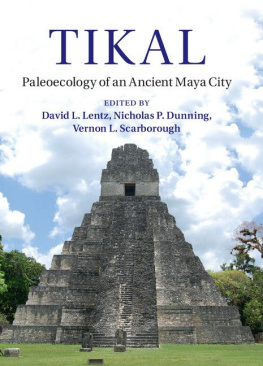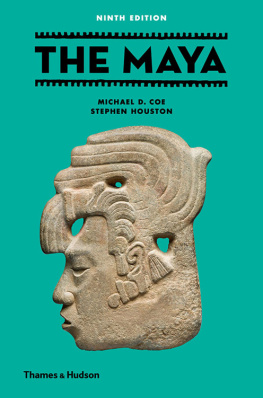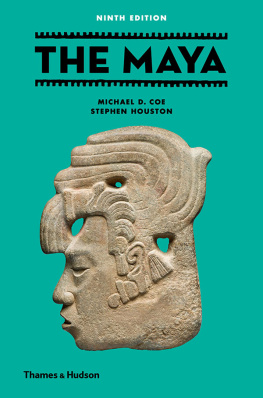Tikal
The primary theoretical question addressed in this book focuses on the lingering concern of how the ancient Maya in the northern Petn Basin were able to sustain large populations in the midst of a tropical forest environment during the Late Classic period. This book asks how agricultural intensification was achieved and how essential resources, such as water and forest products, were managed in both upland areas and seasonal wetlands, or bajos . All of these activities were essential components of an initially sustainable land use strategy that eventually failed to meet the demands of an escalating population. This spiraling disconnection with sound ecological principles undoubtedly contributed to the Maya collapse. The books findings provide insights that broaden the understanding of the rise of social complexity the expansion of the political economy, specifically and, in general terms, the trajectory of cultural evolution of the ancient Maya civilization.
DAVID L. LENTZ is Professor of Biological Sciences and Executive Director of the Center for Field Studies at the University of Cincinnati. He has authored more than ninety publications that have appeared as journal articles, book chapters, and three books, including this volume. His research focuses on anthropogenic landscape changes of the past and paleoethnobotanical studies in Mesoamerica, Central Asia, and North America.
NICHOLAS P. DUNNING is Professor of Geography at the University of Cincinnati. He is a geoarchaeologist and cultural ecologist specializing in the Neotropics. He has published several books and more than ninety articles and book chapters, including those in this volume.
VERNON L. SCARBOROUGH is Distinguished University Research Professor and Charles Phelps Taft Professor in the Department of Anthropology at the University of Cincinnati. His work emphasizes sustainability and global water systems through an examination of past engineered landscapes, using comparative ecological and transdisciplinary perspectives. He has published ten books eight of them edited, including this volume and authored more than ninety book chapters or journal articles.
Tikal
Paleoecology of an Ancient Maya City
Edited by
David L. Lentz
University of Cincinnati
Nicholas P. Dunning
University of Cincinnati
and
Vernon L. Scarborough
University of Cincinnati
32 Avenue of the Americas, New York, NY 10013-2473, USA
Cambridge University Press is part of the University of Cambridge.
It furthers the Universitys mission by disseminating knowledge in the pursuit of education, learning, and research at the highest international levels of excellence.
www.cambridge.org
Information on this title: www.cambridge.org/9781107027930
Cambridge University Press 2015
This publication is in copyright. Subject to statutory exception and to the provisions of relevant collective licensing agreements, no reproduction of any part may take place without the written permission of Cambridge University Press.
First published 2015
Printed in the United States of America
A catalog record for this publication is available from the British Library.
Library of Congress Cataloging in Publication data
Tikal : paleoecology of an ancient Maya city / edited by David L. Lentz, University
of Cincinnati, Nicholas P. Dunning, University of Cincinnati, Vernon L. Scarborough,
University of Cincinnati.
pages cm
Includes bibliographical references and index.
ISBN 978-1-107-02793-0 (hardback)
1. Paleoecology Guatemala Tikal Site. 2. Wetland agriculture Guatemala
Tikal Site. 3. Tikal Site (Guatemala) I. Lentz, David L. (David Lewis),
1951 II. Dunning, Nicholas P. (Nicholas Pierce), 1957 III. Scarborough, Vernon
L. (Vernon Lee), 1950
QE720.2.G9T55 2015
560.450972812dc23 2014015323
ISBN 978-1-107-02793-0 Hardback
Cambridge University Press has no responsibility for the persistence or accuracy of URLs for external or third-party Internet Web sites referred to in this publication and does not guarantee that any content on such Web sites is, or will remain, accurate or appropriate.
Contents
Nicholas P. Dunning, David L. Lentz, and Vernon L. Scarborough
Vernon L. Scarborough and Liwy Grazioso Sierra
Brian Lane, Vernon L. Scarborough, and Nicholas P. Dunning
Christopher Carr, Eric Weaver, Nicholas P. Dunning, and Vernon L. Scarborough
Eric Weaver, Christopher Carr, Nicholas P. Dunning, Lee Florea, and Vernon L. Scarborough
Nicholas P. Dunning, Robert E. Griffin, John G. Jones, Richard E. Terry, Zachary Larsen, and Christopher Carr
Kim M. Thompson, Angela Hood, Dana Cavallaro, and David L. Lentz
David L. Lentz, Kevin Magee, Eric Weaver, John G. Jones, Kenneth B. Tankersley, Angela Hood, Gerald Islebe, Carmen E. Ramos Hernandez, and Nicholas P. Dunning
Kenneth B. Tankersley, Nicholas P. Dunning, Vernon L. Scarborough, John G. Jones, Christopher Carr, and David L. Lentz
David Webster and Timothy Murtha
Palma J. Buttles, Carmen E. Ramos Hernandez, and Fred Valdez Jr.
Timothy Beach, Sheryl Luzzadder-Beach, Jonathan Flood, Stephen Houston, Thomas G. Garrison, Edwin Romn, Steve Bozarth, and James Doyle
David L. Lentz, Nicholas P. Dunning, and Vernon L. Scarborough
Figures
Tables
Contributors
Timothy Beach is Centennial Professor in the Department of Geography and Environment at the University of Texas at Austin. He is an elected AAAS Fellow and has held fellowships from the Guggenheim Foundation and Dumbarton Oaks. His research focuses on soil and agricultural systems, geomorphology, water, environmental change, paleoclimate, and geoarchaeology.
Steven Bozarth is a researcher in the Department of Geography at the University of Kansas. His research interests include palynology, opal phytolith analysis, paleoenvironmental reconstruction, and ancient agriculture.
Palma J. Buttles is Manager and Senior Member of the Technical Staff at the Software Engineering Institute at Carnegie Mellon University and Research Fellow at the Texas Archaeological Research Laboratory, University of Texas at Austin. A recent paper is People Capability Maturity: Contributing to Organizational Success, Joburg Centre for Software Engineering Annual Report (2009) , University of the Witwatersrand, Johannesburg, South Africa.
Christopher Carr is a doctoral student at the University of Cincinnati in the Department of Geography. A recent publication is entitled Map of the Ruins of Tikal, El Petn, Guatemala and Georeferenced Versions of the Maps Therein, which appeared in Tikal Report 11 (tDAR ID: 390922) http://core.tdar.org/project/390922.
Dana Cavallaro recently received her M.S. degree from the Department of Biological Sciences at the University of Cincinnati. Her thesis is entitled Reconstructing the Past: Paleoethnobotanical Evidence for Ancient Maya Plant Use Practices at the Dos Pilas Site, Guatemala.
James Doyle is Post-Doctoral Associate in Pre-Columbian Studies at the Dumbarton Oaks Research Library and Collection. He is the author of the article Re-Group on E-Groups: Monumentality and Early Centers in the Middle Preclassic Maya Lowlands, which appeared in Latin American Antiquity in 2012.









